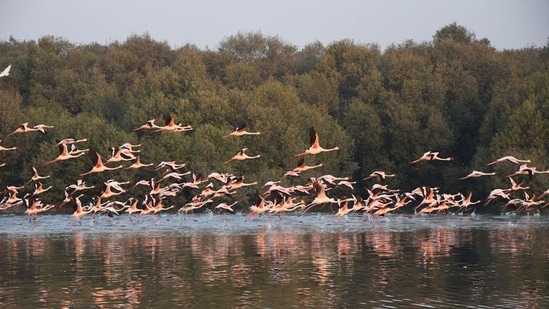‘India's Ramsar site growth is a remarkable contribution to wetland protection’: Ramsar Convention secretary general
In an interview to HT, Musonda Mumba, secretary general of the Ramsar Convention on Wetlands, highlights the importance of ensuring the wise use of wetlands.
Last month, India added two new Ramsar sites, the Nagi and Nakti bird sanctuaries in Bihar, taking the tally of wetlands of international importance to 82. This achievement places India joint third globally with China in terms of the number of Ramsar sites. The United Kingdom has the highest number of Ramsar sites in the world with 175, while Mexico is second with 144 Ramsar sites.

Ramsar sites are wetlands of international importance designated under the Ramsar Convention, headquartered in Gland, Switzerland. The convention — adopted in the Iranian city of Ramsar on February 2, 1971 — aims to promote the conservation and wise use of wetlands through international cooperation and policymaking. The convention has 172 contracting parties with over 2,400 designated Ramsar sites worldwide, covering more than 2.5 million square kilometres. These wetland sites are recognised for their role in conserving global biodiversity and maintaining ecological balance. They offer crucial ecosystem services, such as water purification, flood control, carbon sequestration, regulating water cycles, and acting as natural buffers against extreme weather events, while providing livelihoods for millions.
India added 26 Ramsar sites from 1982 to 2013. However, there has been a substantial acceleration in recent years, with 49 new sites designated from 2014 to 2022. In 2024 alone, India added five more, raising the tally to 82. India's total wetland area is approximately 15.26 million hectares, constituting about 4.63% of the country's geographical area, according to the ministry of environment, forests and climate change (MoEFCC). The 82 Ramsar sites presently cover an area of 1.33 million hectares.
Tamil Nadu has the highest number of Ramsar sites at 16, followed by Uttar Pradesh with 10, Punjab, Gujarat, and Odisha with six, among others. The Sundarbans wetland in West Bengal is the largest Ramsar site in the country, while the Chilika Lake in Odisha is renowned for its biodiversity. Manipur’s Loktak Lake is famous for its unique floating islands called phumdis, while Vembanad-Kol wetland in Kerala is the longest lake in India.
In an exclusive interview, Musonda Mumba, the secretary general of the Ramsar Convention on Wetlands, discusses the strategies and collaborative efforts that have contributed to India's rapid increase in Ramsar site designations, offering insights into the broader implications for global wetland conservation.
India now has 82 Ramsar sites, tying for third highest globally. How does the Ramsar secretariat view this achievement in the context of global wetland conservation efforts?
India is home to a diverse range of wetlands, including rivers, lakes, ponds, marshes, mangroves, and estuaries, across various geographical regions, from the Himalayan foothills to coastal areas. The country has made significant strides in recent years to designate key wetlands of international importance. These efforts contribute to the protection of biodiversity, help combat climate change and provide crucial habitats for millions of migratory birds traversing the Indian subcontinent. The secretariat views this achievement as a remarkable contribution to global wetland conservation efforts.

Has any other country experienced a similar rapid increase in Ramsar site designations?
This rapid increase in the number of Ramsar sites is indeed remarkable. It demonstrates a strong commitment from all stakeholders involved. While other countries have also made notable progress in designating Ramsar sites, India's acceleration in this area is particularly impressive. This achievement highlights the country's dedication to the convention and its efforts to prioritise wetland conservation. India has demonstrated significant ambition in designating more Ramsar sites, and the secretariat is committed to fully supporting these crucial efforts.
Based on the secretariat’s assessments, is India on the right track with its current wetland management practices?
During my visit to Indore for the World Wetlands Day celebration on February 2, 2024, I observed significant civil society involvement in managing Ramsar sites, particularly from Wetland Mitras. This collaborative approach is exemplary for effective wetland management. India is developing rapidly, and conflicts between development and wetland conservation are likely to increase. To ensure the wise use of wetlands, it is crucial to involve all stakeholders in the decision-making process. Continued engagement and collaboration among government entities, local communities, and civil society are essential for sustaining and improving wetland management practices.
In what ways do India’s efforts to include more Ramsar sites align with the UN sustainable development goals (SDGs)?
Protecting wetlands is crucial for achieving the SDGs in India. Wetlands are vital for human well-being, inclusive economic growth, and climate mitigation and adaptation. They provide water for consumption and agriculture, protect shores, and help make cities and settlements safe and resilient. As one of Earth’s greatest natural carbon stores, wetlands play a significant role in climate action. They support biodiversity and unique ecosystems, contributing to life below water and life on land. By expanding Ramsar sites, India enhances its ability to mitigate and adapt to climate change, provide sustainable livelihoods, and ensure human health and wellbeing. Additionally, wetlands offer a myriad of benefits, making them integral to achieving multiple SDGs.
How do communities benefit from Ramsar designations? Are there any programmes in place to ensure that conservation efforts also support local livelihoods?
Local communities benefit significantly from clean and well-maintained wetlands, as they depend on these ecosystems for food, water, and overall well-being. The Strategic Plan 4 of the Convention on Wetlands emphasises the participation of local communities in the management of wetlands. This approach ensures that conservation efforts directly support and enhance local livelihoods. By involving communities in wetland management, these programs help sustain essential resources, promote economic opportunities, and improve the quality of life for those who rely on wetlands for their daily needs.
How does India’s approach to managing its Ramsar sites compare with other countries with a high number of Ramsar sites?
India's approach to managing its Ramsar sites is commendable, particularly with the establishment of the Wetlands of India Portal by the MoEFCC and its knowledge partners. This tool facilitates effective monitoring and management of many Ramsar sites in India.
The secretariat continues to foster a platform for sharing best practices among contracting parties through its capacity development programmes, as well as initiatives under its International Organisation Partners (IOPs) and Ramsar Regional Initiatives (RRIs). This collaborative approach ensures that countries can learn from each other and continuously improve their wetland management strategies.
How important is the role of policy and legal frameworks in the successful management of Ramsar sites?
Policy and legal frameworks are foundational to the conservation and wise use of wetlands. India's enactment of the Wetlands (Conservation and Management) Rules, 2017, represents a significant step towards establishing a robust legal framework. However, it is crucial for policies to continuously evolve and adapt to changing external factors. By continuing to improve its policies, and by learning from the experiences of other nations, India can enhance the successful management of its Ramsar sites.
Continue reading with HT Premium Subscription






